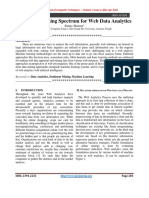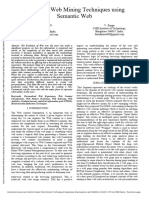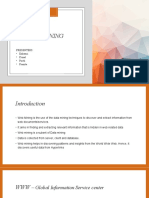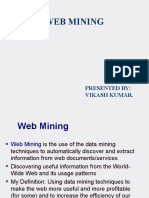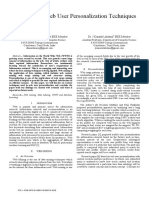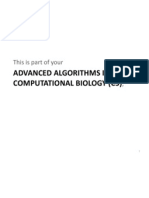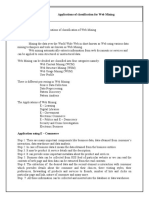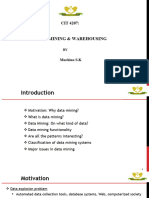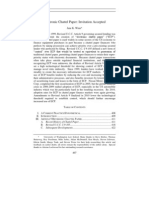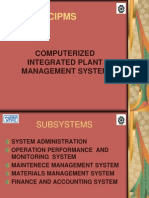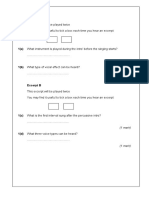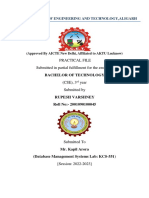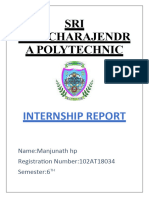Data Mining Techniques for Web Mining: A Survey
Author: Mehdi Gheisari1,2,3 , Hooman Hamidpour4 , Yang Liu2,* , Peyman Saedi5, Arif
Raza6, Ahmad Jalili7, Hamidreza Rokhsati8 and Rashid Amin9
Journal: Bon View Publishing Pte. Ltd.
Page Numbers :25
Year : 25 October 2022
1. Objective
The main objective of the paper titled “Data Mining Techniques for Web Mining: A
Survey” is to explore how data mining (DM) techniques are applied in the domain of web mining
(WM). As digital platforms generate vast amounts of data daily—from blogs and social media to
e-commerce sites—there is a growing need to extract meaningful patterns and insights. DM
serves as a bridge between raw data and actionable information, while WM focuses on handling
the unique characteristics of web data, such as its unstructured or semi-structured format and
dynamic nature. The paper provides a comprehensive overview of these techniques and their role
in processing and interpreting online data. It also highlights the importance of DM in supporting
decision-making, trend prediction, and content personalization across fields like business,
healthcare, and social networks. The survey aims to help researchers and practitioners understand
current methods, recognize challenges, and identify future research directions in this evolving
area.
2. Methodology
The paper uses a survey-based methodology to systematically examine and compare
various data mining techniques applied in web mining. It begins by outlining the six key phases
of the data mining process: business understanding, data understanding, data preparation,
modeling, evaluation, and deployment. These phases offer a structured approach to transform
raw data into meaningful insights. The authors categorize algorithms based on their functions—
clustering for grouping similar data, regression for predicting continuous values, and
classification for sorting data into predefined categories. Advanced techniques like neural
networks, decision trees, and Naive Bayes are also discussed, each suited to specific data types
and problems. Additionally, the paper explores the use of graph theory and Markov models for
analyzing web structures and user behavior, as well as semantic web and ontology frameworks to
add context to unstructured data.
�3. Advantages and Disadvantages
Advantages of DM and WM:
Pattern Discovery: Helps identify user behavior, trends, and anomalies.
Prediction: Useful in forecasting outcomes, such as customer churn or future purchases.
Efficiency: Automates decision-making processes in marketing, healthcare, and social
networks.
Personalization: Enables recommender systems and user profiling.
Scalability: Can handle massive datasets typical of web environments.
Disadvantages
Data Quality: Web data is often noisy, unstructured, or irrelevant.
Privacy Concerns: Potential misuse of personal data mined from the web.
Model Limitations: Some models lack generalizability or are sensitive to parameter
tuning.
Interpretability: Complex models like neural networks act as "black boxes".
Resource Intensive: High computational and storage requirements.
4. Results
The survey emphasizes that data mining, when effectively adapted for web applications,
holds great potential to extract actionable insights from large and complex datasets. instead,
hybrid approaches combining classification, clustering, and predictive models often deliver
better results. For example, combining clustering with regression can improve user segmentation
and behavior prediction. The paper highlights how businesses use these techniques to enhance
customer relationships, personalize content, and boost engagement through recommender
systems. In healthcare, DM helps analyze patient records for treatment optimization, while social
networks use graph algorithms to uncover community structures and user influence.
The study also points to the future of web mining in integrating technologies like artificial
intelligence, semantic web, and dynamic graph analysis to address challenges such as data
heterogeneity, high dimensionality, and evolving user behavior. Markov models are effective for
modeling user navigation patterns, while semantic web technologies add context to raw data,
enhancing search and classification. The paper concludes that ongoing research will not only
improve existing methods but also expand their use in areas like e-learning, IoT, and
personalized healthcare. Ultimately, the survey highlights data mining’s transformative impact
on the web and calls for continued innovation in scalable, user-focused solutions.
�Filename: work april
Directory: D:\Ph.D Thesis work\New folder (2)
Template:
C:\Users\lenovo\AppData\Roaming\Microsoft\Templates\Normal.
dotm
Title:
Subject:
Author: lenovo
Keywords:
Comments:
Creation Date: 4/12/2025 8:31:00 PM
Change Number: 2
Last Saved On: 4/12/2025 9:02:00 PM
Last Saved By: lenovo
Total Editing Time: 28 Minutes
Last Printed On: 4/12/2025 9:02:00 PM
As of Last Complete Printing
Number of Pages: 2
Number of Words: 684 (approx.)
Number of Characters: 3,902 (approx.)









